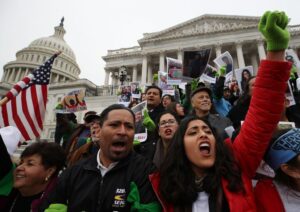12:17
Brief
News Briefs
Millions more workers would receive overtime pay under proposed Biden administration rule
Salaried workers who have been ineligible for overtime pay would benefit from a proposed Biden administration regulation.
The Department of Labor’s new rule would require employers compensate full-time workers in management, administrative, or other professional roles for any overtime worked if they make less than $55,068 annually. Currently, the salary threshold is $35,568. The change is expected to affect 3.6 million workers.
The rule would also provide automatic changes every three years to the salary level to keep up with changes in earnings. U.S. territories that are subject to the federal minimum wage would have these same overtime protections, which rolls back a Trump administration change made in 2019.
“I’ve heard from workers again and again about working long hours, for no extra pay, all while earning low salaries that don’t come anywhere close to compensating them for their sacrifice,” said Acting Secretary of Labor Julie Su in a statement.
The new standard salary level proposed by the agency would be tied to the 35th percentile of weekly earnings of salaried workers in the lowest-wage region of the country. There is voter support for a change in the current regulations. According to a 2022 Data for Progress survey of likely voters, 65% said they either strongly supported or somewhat supported raising the salary threshold for overtime pay.
The rule will go through a public comment period as part of the rulemaking process to give supporters and opponents time to offer feedback. The process can take months, which could mean it won’t be finalized until next year. Labor rights advocates and economists say that people working in retail, restaurants and healthcare would be among the workers most affected by the regulation.
Judy Conti, director of government affairs at the National Employment Law Project, a worker advocacy nonprofit, said many workers who do overtime eligible work are paid just over the current threshold so their companies can avoid paying time-and-a-half. The proposed rule would help address this, she said.
“A lot of these dollar stores call people managers and supervisors and pay them $36,000 a year. Then they claim that they’re overtime exempt and they may do a little managing and they may do a little supervising, but mostly they’re working the cash register or they’re stocking shelves or they’re unloading in the back. They’re not doing work that is considered truly bona fide executive, professional or administrative work,” she said.
Conti added that this rule would provide incentive to employers to manage employee time wisely or hire more workers to handle the workload.
“… There’s [currently] no incentive to really manage that time wisely and see if it should instead be spread to other people,” Conti said.
Erica Groshen, senior economics adviser at the Cornell University School of Industrial and Labor Relations, said the regulation should be fair on employers.
“I think the important thing to realize is that this will affect all of those employers equally,” she said. “It’s not putting some at a disadvantage compared to others. It’s going to change the playing field for everybody. You could argue that it’s going to change the playing field more for employers who were actively trying to take advantage of the erosion of the applicability of the law.”
In terms of the potential effects on the economy, Groshen said there could be some pass through to prices for consumers depending on how competitive the industry.
“To the extent that these companies are quite profitable, then the employers might try to hold on to market share by not increasing prices as much. Their profits might be a bit lower. Right now, nationally profit rates are actually quite high. They’ve been high for a while and rising. This would tend to reduce inequality if it comes out of profits. Otherwise, then the money is going to come from somewhere,” Groshen said.
That may mean that some employers will automate more services such as electronic ordering at restaurants or buying equipment for food preparation, she added.
The Trump administration last changed the salary threshold in 2019 from $23,660, set in 2004, to its current $35,568 salary level, which was significantly lower than the $47,476 level the Obama administration tried to implement in 2016. A federal judge blocked the Obama administration’s effort saying that the threshold was too high and that the administration did not have the authority to make that particular change.
Twenty-one states, including Nevada, Arizona, Kentucky and Wisconsin, brought the lawsuit. The states argued that the rule “could deliberately exhaust state budgets” and was unconstitutional. In 2017, the same judge, an Obama appointee, ruled against the regulation again.
Conti said she’s optimistic that the rule is less likely to be blocked this time. She argues that the judge’s reasoning for stopping implementation of the rule lacked “legal or economic support.” Attorneys for law firms specializing in employment and labor law, however, are still anticipating legal action against the rule. Some attorneys suggest that the lack of a Senate-confirmed labor secretary makes the regulation more vulnerable to legal action. Biden nominated Su for labor secretary six months ago.
Many of the same groups that opposed or were critical of the overhaul of overtime regulations during the Obama administration have taken similar positions on the Biden administration’s effort. The U.S. Chamber of Commerce has called on the Department of Labor to “adjust” the rule. It did not release any specifics for what it wants the agency to do, but criticized the department’s proposal to automatically change the salary threshold every few years.
“The Department of Labor’s proposed overtime regulation is the wrong rulemaking at the wrong time,” Marc Freedman, vice president of the U.S. Chamber of Commerce Workplace Policy, said in a statement. “It represents a more than 50% spike in the salary threshold and will increase costs for small businesses, nonprofits, and other employers at a time when businesses already face persistent workforce shortages that are hindering the economy.”
Industry groups such as the National Restaurant Association and National Association of Manufacturers have been critical of the rule for similar reasons.
Conti said she sees the proposed rule as stimulating for the economy and good for employees as well as employers.
“Adding jobs and getting more money into more people’s hands is good for the economy,” Conti said. “We’ve seen a lot of workers over the past couple of years walking away from jobs when they’re overworked, when they don’t have time for themselves and when they don’t have time for their families. Making sure that workers have moderate work weeks that are 40 hours is good for employers. They’re not going to burn out their employees.”
Our stories may be republished online or in print under Creative Commons license CC BY-NC-ND 4.0. We ask that you edit only for style or to shorten, provide proper attribution and link to our website. AP and Getty images may not be republished. Please see our republishing guidelines for use of any other photos and graphics.





